
THE KELPIE
STORY
FAMOUS AUSTRALIAN WORKING
KELPIES AND THEIR HISTORY
By Stephen & Mary Bilson
Early Australian Working Kelpie
History
The Kelpie breed was formed
in Australia around the mid 1800's by a number of keen dog breeder. There is more information on the formation of
the breed on our 'Where did the Kelpie come
from' page. This section shows the
work done by the early breeders in developing the Kelpie.
It is important to understand that the Kelpie was
not bred from Border Collies. The first Border Collie did not arrive in
Australia until 1901.
_______________________________
GLEESON'S KELPIE
Jack Gleeson, a young stockman born in
Ireland around the early 1840's, was working on a property called
Murray Dunrobin Station in Victoria. One day he was on a visit to the
adjoining property, Warrock, and noticed some puppies had been born out of a
good working bitch there. The owner of the property, George Robertson, would not sell any females
as he did not want others to benefit from his breeding. Mr.
Robertson, was originally from Scotland.
Soon Jack found out that a young nephew
of the owner had a lovely bitch puppy from a recent litter born on Warrock Station. A number of stockmen had already made offers for the
pup and were refused. Then Jack offered to buy the black and tan
bitch pup. The lad would not sell her as he feared getting into
trouble from Mr. Robertson. A number of
offers were rejected until a lovely pony that the boy liked was
offered in exchange. Jack left the area at the time of the exchange and
took the young pup with him.
He named the pup, 'Kelpie'. She was a black
and tan colour with some white on the chest and under her jaw. She
had tan legs and erect ears that slightly turned over at the tips.
Her ears were said to go up and down as she worked. Jack next went to Ballarook Station
which was also in that western Victoria area and it was
there he broke-in and trained Kelpie during the shearing season. The Kelpie name is a Celtic
word for a mythical watery ghost that called people to streams and drowned
them. It often appeared in the form of a horse or a woman.
Jack later named another of his dogs
'Corby' after Celtic mythological ghosts and spirits. Gleeson's Corby
was a red dog and was later owned by Jack Murray, an Aboriginal
Woolongongh stockman. Gleeson's last pup was said to be Wylie, a
small, rough-haired black dog.
Warrock Station where Gleeson's Kelpie was
bred is now a historic site open to visitors and is a short drive from the town
of Casterton. The well built brick dog kennels are still standing. Every year
the town holds a three day Kelpie Festival which includes Australia's biggest
working dog auction.
NOTE: This is the official version of the breeding of
Gleeson's Kelpie. Another reported version suggests that Gleeson's
Kelpie was the product of a Dingo sire. (See the section on
Dingoes).
_______________________________
RUTHERFORD AND TULLY SHEEPDOGS
Jack stayed in Victoria for a couple of years and
then met up with his friend Mark Tully and was given a black dog called Moss
that was a Rutherford strain sheepdog. These dogs were not Border Collies
but were one of more than 500 breeds of working sheepdogs that existed in
Britain during the 1700'S and 1800'S.
In the northern highlands of Scotland
they were sometimes called, North Country Colleys. Mr. Ross Rutherford, a
descendant, told us that they often called them 'Kildonan Clean Bred Collies'.
In Australia, they were sometimes referred to as Rutherford sheepdogs although a
line of them were referred to as Tully's right through to the early 1900's
because of their strong association with Robert and Mark Tully.
TULLY'S MOSS
Later Jack Gleeson mated Tully's Moss and Kelpie
together. Tully's Moss was also later mated to Kelpie's daughter, Kings Kelpie and produced a black and tan dog
known as Kings Clyde, owned by Henry King. Kings Clyde won a sheepdog
trial at Hay in the early 1800's.
_____________________________
Jack Gleeson next went to work on a
property called 'North Bolero', near Ardlethan in NSW, as an overseer
and became known for his good working dogs. This property was managed by the Quinn
family and John Quinn who later to become famous for his Kelpies, was a
young boy on the property at the time.
______________________________
THE ELLIOT AND ALLEN
PARTNERSHIP
The partnership of Elliot and Allen
imported two high class sheepdogs from Scotland in approx. 1869, to their property, Geralda Station near Young in NSW. These
sheepdogs were a male and female called Brutus and Jenny. Jenny had
half pricked ears and a longish coat. They were both black
and tan in colour. They were mated on the voyage out to Australia and
shortly after arrival, Jenny whelped. Two of the pups were a reddish colour and
the others were black and tan. One of these pups was called Caesar.
Not long after Brutus and Jenny arrived,
Brutus won a Sheepdog Trial at Young,
NSW, in 1871. The following year, 1872, Brutus again won the same
trial.
The partnership of Elliot and Allen only
ever had this one import of sheepdogs as Elliot was killed in an accident. William Allan
left the Young district in 1874, and took his dogs to Queensland.
___________________
_________________________________________________________________
KINGS KELPIE
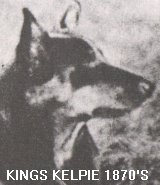 When Jack Gleeson was working on 'North Bolero', he was
able to use Caesar (Brutus X Jenny) to mate to
his Kelpie. One of the pups (also a black and tan) from this mating
he gave as a present to Mr. Charles Thomas. King who was managing
Woolongongh Station, Humbug Creek, between Condobolin and Ungarie.
When Jack Gleeson was working on 'North Bolero', he was
able to use Caesar (Brutus X Jenny) to mate to
his Kelpie. One of the pups (also a black and tan) from this mating
he gave as a present to Mr. Charles Thomas. King who was managing
Woolongongh Station, Humbug Creek, between Condobolin and Ungarie.
He decided to call her Kelpie after her mother. In
some early references she was referred to as Young Kelpie and even Kelpie II but
soon became known as as Kings Kelpie. After her excellent performance at the
1879 Forbes Trial people, often referred to the strain of dogs as Kelpie's pups,
or just Kelpies and the name has stayed ever since.
Henry (Harry) King, a brother of Charles
King also bred Kelpies and we know he won a trial at Wagga around
1881 with a kelpie called Red Jessie. Walter King (one of the
original King family) said later that Red Jessie was the greatest
trial dog he ever saw. Red Jessie was quoted as being the same
breeding as Kings Clyde but from a later mating. From reports it
seems that Harry King was very interested in Sheepdog Trials and was
well known as a top competitor.
PEDIGREE OF KINGS
KELPIE
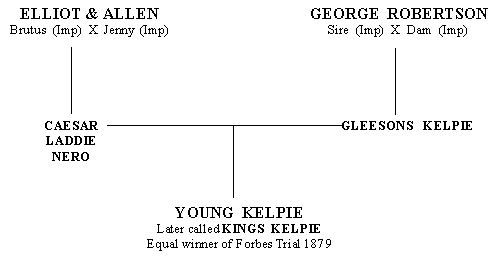
THE FAMOUS FORBES TRIAL OF
1879
In 1879, a sheepdog Trial was advertised
to be held along with a big show at Forbes in the the Central west of
NSW. The dogs entered some of the best dogs in the country and included Jack
Gleeson's Corby, Gibson's Tweed and Bet, and Mr. Charles King's Kelpie, bred by
Jack Gleeson from Kelpie and Caesar.
The trial awarded a equal first prize to Kings Kelpie and Gibsons Tweed. The prize money was 20 Guineas (£20, and 20
shillings). The trial was watched by hundreds of spectators.
Charles Gibson originally came from Tasmania to NSW. Mr.
Gibson sent down to his uncle in Tasmania for Tweed, especially to work in this
trial.
This fact got a lot of publicity and showed the public just how
serious the competitors were.
___________
Jack Gleeson married Mary Ryan in 1878
when he had moved to North Yalgogrin. Mary Ryan's sisters, Kate and
Grace also married into families that are well known in the formation
of the Kelpie breed. Kate (Elizabeth) married Henry (Harry) King,
whose father owned Woolongough Station. Grace married Pat Cox, whose
father John Cox, owned North Yalgogrin Station, where Jack Gleeson
later worked as Superintendant.
Jack Gleeson moved from North Bolero to
North Yalgogrin and then finally to Lake Cowal as manager. When he
moved to Lake Cowel he left his old dogs with friends and took a
young Kelpie called Wylie. He told his good friend, Robert MacPherson
that he thought Wylie was going to be as good as her mother, old
Kelpie. Shortly afterwards he died of hepatitis, just two years after
he was married, in 1880. He was only 36 years old at the time and
left behind a wife and a son, Denis John Gleeson, who was only a few
months old. His son, who also called himself John Gleeson, died in
1965.
If you have any additional information, we'd
love to hear from you
Mary and Stephen Bilson  Noonbarra Kelpie
Stud
Noonbarra Kelpie
Stud
P.O. Box 1374, Orange NSW,
Australia
Email:
kelpiestory@noonbarra.com
www.noonbarra.com
More information on
Kelpie history can be found
in
the latest edition of our
book
FAMOUS
KELPIES
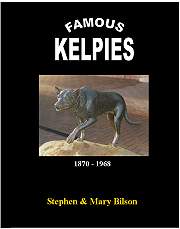
We also have our new 2007 edition of The Rockybar Kelpies available
THE ROCKYBAR KELPIES
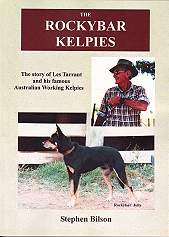
New for 2007, Kelpie history, Kelpie training, Kelpie breeding and great stories
all from one of Australia's past best known Australian Working Kelpie Studs.
CLICK HERE FOR MORE INFORMATION
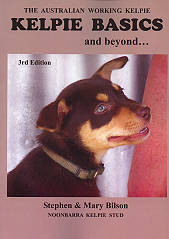
New 3rd edition of this very popular manual designed for
all Kelpie owners of every level from raw beginners through to experienced
trainers. This practical manual deals with everything involved in owning and
training a Kelpie to ensure he grows up to be a well mannered, obedient dog.
The book is not about training on livestock! It deals with
general obedience training, socialising your Kelpie, feeding, crating, toilet
training, preventing problem behaviour, dominance issues, car travel, bathing,
digging holes, stealing food, walking on a lead, coming when called... and much
more.
Over 100 pages.
Click here for more details

 When Jack Gleeson was working on 'North Bolero', he was
able to use Caesar (Brutus X Jenny) to mate to
his Kelpie. One of the pups (also a black and tan) from this mating
he gave as a present to Mr. Charles Thomas. King who was managing
Woolongongh Station, Humbug Creek, between Condobolin and Ungarie.
When Jack Gleeson was working on 'North Bolero', he was
able to use Caesar (Brutus X Jenny) to mate to
his Kelpie. One of the pups (also a black and tan) from this mating
he gave as a present to Mr. Charles Thomas. King who was managing
Woolongongh Station, Humbug Creek, between Condobolin and Ungarie. 



